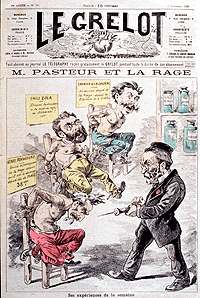
The live vaccine

Elaborating his studies on fermentation, Pasteur was able to confirm that each disease is caused by a specific microbe. He used this knowledge in his research on infectious diseases. He studied the microbe responsible for chicken cholera. Pasteur and his partners made a broth containing the microbe. They injected this into a sample of chickens, but all of them died. This broth was left while Pasteur went on holiday, on returning the old culture was injected into another sample of chickens. After a mild reaction, the chickens survived. A stronger culture was then injected into the same chickens, they survived again. In this manner the live vaccine was discovered. The live vaccine is mild form of a pathogenic microbe that stimulates the immune system to produce antibodies that attack the microbe.
 The process of
inoculation was called "vaccination" in honor of
Edward Jenner, a scientist who noticed that milkmaids exposed to cow pox did not
contract small pox. The word vaccine is derived from the Latin 'vacca',
meaning cow.
The process of
inoculation was called "vaccination" in honor of
Edward Jenner, a scientist who noticed that milkmaids exposed to cow pox did not
contract small pox. The word vaccine is derived from the Latin 'vacca',
meaning cow.
Pasteur rapidly adapted the principle of the
vaccination to other diseases, like anthrax. Several farmers were
sceptical: they did not want their sheep to receive a live injection.
Pasteur constructed a large demonstration: he took a sample of 50 sheep and
injected half with a mild culture of anthrax but did not inject the others.
Another 50 sheep were also used as a control. After several days all 50
sheep were injected with a strong dose of anthrax. The 25 that were inoculated
survived but the others died. It was a great success.
In 1880 Pasteur began studying rabies. In 1885 the vaccine was tested with success on a young boy - Joseph Meister, who was bitten by a dog carrying rabies. Over ten days Joseph received a series of 13 injections of increasing strength. He never contracted rabies. Today there is still no cure for rabies but its prevention has made it possible to eliminate this disease in many countries.
A satirical picture showing Pasteur giving an injection